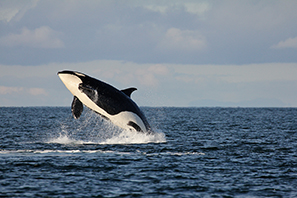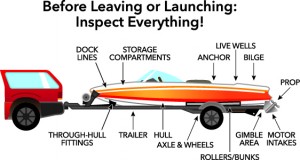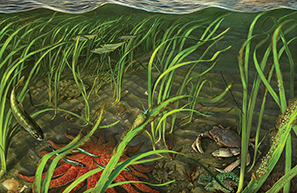Boating is a common pastime on our rivers, lakes, and on the Salish Sea. Fun on the lake or sea with family and friends is a great way to pass a summer afternoon. This guideline is full of pointers to ensure you can navigate your way to being a great boater!
In this Guideline:
-
References for Guideline 7
-
Sound Information: A Boaters Guide, 60 p, Puget Soundkeeper Alliance, 2012-13
Kelp and Eelgrass in Puget Sound, Thomas Mumford, Jr, 34 p, Puget Sound Nearshore Partnership Technical Report 2007-05, US Army Corps of Engineers, 2007.
Marine Invasive Species Identification Guide for the Puget Sound Area, Ann Eissinger, 38 p, Puget Sound Parnership & Washington State Dept of Fish and Wildlife, 2009.
On the Lookout for Aquatic Invaders, Scott Wiedemer and Samuel Chan, 72 p, Oregon Sea Grant, 2008.
Orcas in Puget Sound, Birgit Kriete, 24 p, Puget Sound Nearshore Partnership Technical Report 2007-01, US Army Corps of Engineers, 2007.
Sport Fishing Guide: Crabbing in Puget Sound, Brochure, Washington Department of Fish and Wildlife, 2010.
-
Crabbing Successfully
-
Everyone wants to go home with crabs, and their crab pots, after a day of crabbing. In recent years, we’ve seen record numbers of Dungeness crabs being harvested in Puget Sound, and it is important that all crabbers follow the rules to sustain the population for future years. Recreational crabbers are the largest population of crabbers out there, so our cumulative actions can have an immense impact.
Help keep the crab population strong by:
- Checking the current Fish & Wildlife Regulations before you go.
- Keeping only male crabs 6 ¼” and larger.
- Checking for soft-shell crabs in your pot and return them.
- Recording your catch.
- Ensuring your traps are well secured to prevent loss in the water.
Learn more by picking up your free regulation booklet, which has maps of crab catch areas, how to measure crabs and check for shell hardness, equipment regulations, sizes, and limits. Check the WDFW website for seasonal information and which days of the week you may crab.
How to keep your crab pots
Each year, over 12,000 crab pots are lost and wind up on the bottom of Puget Sound. Those pots trap and kill the equivalent of 178,000 male, harvestable crabs annually!
Keep your pot by:
- Staying with your pots whenever possible.
- Using a GPS unit to record the exact position of your pots.
- Using escape (or rot) cord that is 100% natural, such as cotton, jute, or hemp is the law in Washington. These biodegradable cords rot away in two to three months and leave an opening for crabs to escape if your pot is lost. This will prevent an estimated 30 legal size crabs a year from dying in your lost pot!
- Weighting your lines because a passing boat will not see a floating line and can cut it as it passes by. Buy leaded line or purchase weights and attach those to your line. You should weight your pot too, especially if you are crabbing in areas with strong currents or during large tidal exchanges.
- Checking the water depth before you lower your pots. Use a line that is one-third longer than the water depth to ensure that you won’t lose your pot due to deep water, high tides, or strong currents that pull the pot sideways as you lower it to the ground.
- Steering clear of high traffic areas such as shipping lanes and ferry route. Commercial vessels do not detour for crab pots. Also avoid sailing regatta courses since boats under sail are not very maneuverable and their deep keel can easily snag your crab line.
-
Watching Whales
-
 You may come across a whale when out boating. Keep your distance and know the laws. There are specific laws protecting killer whales (orcas) and other marine mammals. When encountering marine mammals slow down or stop and avoid the path of the animal. Stay on the offshore side if whales are traveling close to shore.
You may come across a whale when out boating. Keep your distance and know the laws. There are specific laws protecting killer whales (orcas) and other marine mammals. When encountering marine mammals slow down or stop and avoid the path of the animal. Stay on the offshore side if whales are traveling close to shore.
-
Preventing the Spread of Invasive Species
-
 Aquatic nuisance species, such as the New Zealand mud snail and Eurasian milfoil, pose a serious threat to the biological diversity and economy of Washington. Many non-native invasive species spread rapidly in areas that do not have their natural predators. These organisms are spread unintentionally as hitchhikers on boats, trailers, and gear. It is against Washington state law to transport any aquatic nuisance species. Be sure to thoroughly inspect and rinse your boat (including jet skis and kayaks), fishing equipment, and wading boots.
Aquatic nuisance species, such as the New Zealand mud snail and Eurasian milfoil, pose a serious threat to the biological diversity and economy of Washington. Many non-native invasive species spread rapidly in areas that do not have their natural predators. These organisms are spread unintentionally as hitchhikers on boats, trailers, and gear. It is against Washington state law to transport any aquatic nuisance species. Be sure to thoroughly inspect and rinse your boat (including jet skis and kayaks), fishing equipment, and wading boots.
-
Protecting Eelgrass Habitat
-
As a boater, you can have a great impact on eelgrass. Although it may just look like a grassy field growing underwater, an eelgrass meadow is brimming with life. Your propeller, anchor or crab pot can quickly harm and even destroy an eelgrass meadow.
The eelgrass meadow is used as a nursery by perch, crab, salmon, and Pacific herring. Juvenile salmon use eelgrass beds as a protective location to hide from predators, grow, and feed. Eelgrass meadows can cushion the impact of currents and waves, trapping sediments and protecting against erosion. When eelgrass leaves die they break down, providing food for worms, shellfish, and sea stars.
Eelgrass grows in locations without strong wave action and good water clarity on sandy and muddy bottoms from the intertidal zone down to a depth of about 35 feet. The leaves are long and slender, measuring about a half inch in width and up to 3 feet long.
- Slowing down or stopping when cruising over eelgrass. Propellers can cut eelgrass and boat wakes can disturb the sediment that protects the root system.
- Avoiding anchoring over eelgrass beds. Anchors hold poorly in eelgrass, tear out eelgrass when pulled up, and the chain acts like a slow moving weed trimmer as the boat rotates around the anchor below.
- Avoiding dropping crab pots into eelgrass beds. Eelgrass will wrap around your crab pot rope and trap, tearing out eelgrass as you retrieve the trap and make a mess on the deck of your boat.
- Installing mooring buoys correctly. Rotating mooring chains scour eelgrass habitat. DNR must approve mooring buoys and other agencies may also require authorization.
-
Boating for Clean Water
-
In 2011, there were nearly 145,000 vessels registered in the counties that border Puget Sound. This does not include the thousands of rowboats, kayaks, canoes, sailboats, inflatable boats, and other personal watercraft that do not require registration. If everyone is a responsible boater we can protect water quality and aquatic life.
DID YOU KNOW? All boaters born after December 31, 1954, must have a Washington State Boater Education Card if operating a personal watercraft or boat of 15 horsepower or more. The card is available through Washington State Parks (www.boat-ed.com/washington).
Being careful with your trash
Litter, such as plastic bags, fishing line, styrofoam and other debris can injure, trap, or kill animals and birds. It can also foul propellers and block the cooling water intake on your engine. It’s illegal to dump trash overboard, so dispose of it in a proper location on land.
Storing untreated sewage onboard
It is against the law to discharge untreated sewage within three miles of shore, which includes the San Juan Islands, all of Puget Sound, and all fresh water tributaries. Many boaters pump out their sewage at pumpout facilities located at many state parks and marinas. A portable toilet is a good option for small boats.
Preventing bilge waste from entering Puget Sound
The bilge collects a variety of fluids that have dripped or leaked in your boat including oil, fuel, and antifreeze. People used to squirt detergent into the bilge but this only breaks oils into smaller floating droplets that end up covering a greater surface of the water. This is now illegal and harms the larval stages of many marine creatures. Many marinas do not allow bilge water to be pumped into their oil recycling containers. The best practice is to keep oil from entering the bilge in the first place.
You can reduce bilge in your boat by:
- Maintaining your engine and frequently checking it for leaks.
- Fitting a drip tray under your engine to catch leaks.
- Wiping up drips, splatters and spills immediately.
- Securing an oil absorbent pad in your bilge or placing it under your engine. The pads do not soak up water, only the oil, and are very effective. Use gloves to wring out oil into a container for recycling, and reuse the pad.
- Installing an inline bilge filter designed to remove petroleum products from bilge water without restricting the performance of the bilge pump. This allows a clean discharge.
Stopping fuel spills
In North America, recreational boating contributes more than a quarter billion gallons of hydrocarbon pollution into our waters every year, which is more than 15 times the amount of oil spilled by the Exxon Valdez. It is the tiny little spills that most boaters experience that add up to this huge number.
Prevent spills by:
- Filling your fuel tank to no more than 90% of capacity.
- Filling your tank slowly to prevent overflow.
- Installing a “No Spill” device to catch spills from the fuel vent.
- Don’t transfer fuel when you are on the water.
- Upgrading to a four-stroke or 2006-compliant two-stroke engine.
You are legally responsible to report spills to both the Washington State Department of Ecology’s “Spills Aren’t Slick” hotline, 1-800-OILS-911, and the Coast Guard, 1-800-424-8802.
Practicing slip-side maintenance
A quick freshwater rinse when you return to dock will prevent the need for harsh cleaners and keep your boat looking good. Because cleaning products and paint can harm marine life, where possible clean, sand, and paint your boat on land. If you must work on your boat in the water, prevent cleaning agents, scraped paint, or solutions from getting in the water.
Spotlight
Resources
Green Boating, Washington State Recreation and Conservation Office
Safe Whale Watching, NOAA Fisheries.
